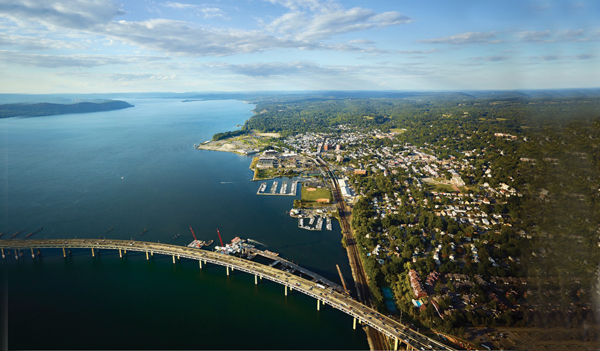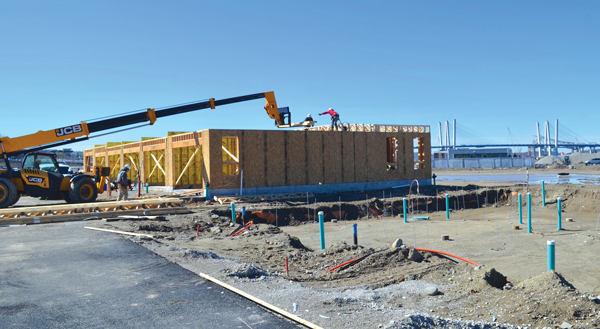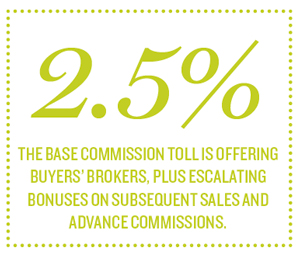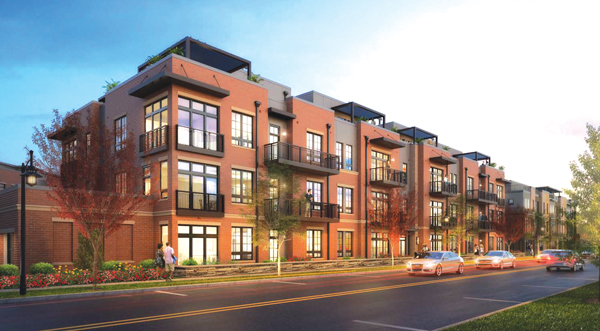Trending
Can Edge-on-Hudson become a game changer for Sleepy Hollow?

Twenty-five miles north of Manhattan, the village of Sleepy Hollow is finally getting an awakening.
Construction crews are toiling away at Edge-on-Hudson, the sprawling 70-acre, $1 billion project that’s being developed on the site where a giant General Motors plant churned out cars until shuttering in the 1990s.
Once complete, the project will add 1,177 new residential units, a 140-room hotel and retail and commercial space to this small Westchester enclave — along with new roads, parks, trails and waterfront access.
For a village with a population of just over 10,000, it’s nothing short of game-changing.
“I believe the statistic is that this job essentially doubles the size of the village of Sleepy Hollow,” said James Fitzpatrick, division president for Toll Brothers, the national homebuilder that’s developing the project’s first residential phase.
But after years of delays, the project — whose master plan is a joint venture between the California-based SunCal and New Jersey-based Diversified Realty Advisors — is hitting at the same time as a slew of other multifamily projects throughout Westchester.
Although Edge-on-Hudson is larger than many of those developments, sources say it has a few key advantages, including the fact that it’s on the waterfront. In addition, its closest competitor, Hudson Harbor, which is located in nearby Tarrytown, is nearing completion, said Therese Militana Valvano, an associate broker at Coldwell Banker’s Dobbs Ferry office.
Phase one of Edge-on-Hudson includes 72 brownstone townhomes, 46 condos and 188 rentals.
Ten of the brownstones, which start at just under $1 million, have sold since sales launched in early January. The condos — which are reportedly priced between about $600,000 and $1 million — are expected to go on the market in June.
Details on the rental rollout are still pending, but sources don’t expect Toll to have any major issues leasing up its inventory.
“The rental market has been on fire, and we see no signs of that letting up,” said Andrew Gerringer, managing director of new business development with the Marketing Directors, which is not affiliated with the project.
“I think that Edge will do well as long as the price and product remain attractive,” Gerringer said. “I’m not aware of a tremendous amount of product in the pipeline for that area, so the market should be able to absorb it all, even if it takes a little while longer than the developers had anticipated.”
Out of the dark period
When the GM plant closed in 1996, the area entered a “dark period,” said Rob Astorino, who was a local council member in the area from 1992 through 2003.
At one point, the plant accounted for nearly half of the village’s tax revenue.
“That piece of property became a symbol of despair,” said Astorino, now a senior adviser with the Manhattan-based law firm Davidoff Hutcher & Citron.
The revitalization of the parcel, which is sandwiched between the waterfront and the Metro-North rail line, had false starts.
New Jersey developer Roseland Residential Trust, now a subsidiary of Mack-Cali Realty, went into contract to buy the site in 2000 and was planning a giant mixed-use project dubbed Lighthouse Landing.
But the site was the source of a legal battle, and the firm pulled the plug after the recession hit, according to Jonathan Stein, a former partner at Roseland.

Construction on Toll Brothers’ brownstones
That deal, however, planted the seeds for what was to come: GM later set up a meeting between Stein, who went on to launch Diversified, and SunCal. And the duo ended up buying the site in 2014 for $39.5 million. (The companies also have a hedge fund backer, which Stein declined to name.)
Toll bought the land for the residential portion once the site was “shovel-ready,” said Peter Chavkin, SunCal’s lead consultant for Edge-on-Hudson, who noted that the full project will likely take seven years to complete.
Toll’s Fitzpatrick said the firm wanted to capitalize on outdoor space, especially for the brownstones.
“A site like this at first glance might appear pretty dense,” he said. “While there’s a lot of green space, the ability for people to have their own personal outdoor areas seemed limited.”
But the firm plowed forward, and the finished product will include that outdoor space, with some rooftop terraces featuring outdoor kitchens and fireplaces.
The company, which began offering virtual reality tours of the site this year, is at least partially counting on those luxury amenities to be a selling point.
“While Hudson Harbor has some rooftop decks, they don’t have the outdoor kitchens,” said Compass’ Francie Malina, who specializes in Westchester’s Rivertowns, where Sleepy Hollow is located.

For buyers coming from Manhattan and Brooklyn who are not looking for a house on a cul de sac, that is likely to be attractive. “That’s a pretty unique feature in this marketplace,” Malina noted.
The Edge’s edge
Many expect Edge-on-Hudson to have a significant impact on the surrounding Westchester residential market, which had seen notoriously tight inventory from 2013 until last spring.
“We had a crazy hot market complete with bidding wars, but then things started to shift, and they continue to transition,” said Malina. “There were many less buyers, and prices had gotten so high that the market had to adjust.”
Inventory has, however, been on the rise as developers have rushed to build rentals, banking on the fact that lower Westchester’s proximity to the city and mass transit access will be a draw.
According to the Marketing Directors, 2,255 rental units — the bulk of them in New Rochelle and White Plains — are scheduled to come online in Westchester in the next three years. New condo construction, however, has been less abundant.
“It’s likely that as much as 75 to 80 percent of what will be coming to the market across the county will be rentals,” said Gerringer. “Unless you’re well-heeled financially, it’s very unlikely that you’ll be able to secure a condo construction loan in today’s market. No one really knows the depth of the Westchester condo market, but things should be okay because of the limited inventory.”
Meanwhile, the rest of the area’s residential market has been a bit rocky recently.
In 2019’s first quarter, there were 147 closed sales in the Rivertowns, according to Miller Samuel’s latest market report. That’s up about 8 percent year over year, but down roughly 17 percent on the quarter.
Average sales prices in the area — which includes Ardsley, Tarrytown, Dobbs Ferry, Hastings-on-Hudson, Irvington, Mount Pleasant (which includes Sleepy Hollow) and several others — plunged 29 percent to $675,682 in the first quarter from $958,019.
One outstanding question is whether Toll can fetch higher prices in that climate.

A rendering of condo-loft buildings at Edge-on-Hudson
“Relative to New York City and even most of Westchester, buyers have embraced the near-$1 million price range,” said Coldwell Banker’s Valvano. “In the last few years, properties entering the market between $1 million and $1.3 million do not tend to last, particularly if they are young or renovated.”
But Compass’ Malina noted that taxes are higher in Mount Pleasant than they are in some neighboring areas, including Tarrytown, which is in the town of Greenburgh and home to rival Hudson Harbor. “For that reason, I think that it might struggle a little more,” she said.
In what seems like a nod to the competition and uncertain market, Toll Brothers, which is marketing the project in-house, told The Real Deal that it’s tailoring concessions to each buyer.
And it’s implemented an “Agents Rewards” program for buyers’ brokers in Westchester and Dutchess counties who bring in deals. Those incentives include a 2.5 percent base commission plus escalating bonuses on subsequent sales and advance commissions.
A river runs through it
Astorino said that while Edge-on-Hudson will have a “big upside,” he has some concerns around the infrastructure.
“Let’s assume that there’s one car per unit,” he said. “You’re adding 1,100 new cars into a small area with small roads.”
There will also be an influx of children entering the school district and additional needs for other services, like police, fire and sanitation.

“You have increases in tax revenue, and a vibrant new area that brings local spending,” Astorino said. “But there’s a part that’s going to cause some headaches for people as well, [which] will need to be mitigated as the project moves along.”
Chavkin, the Edge-on-Hudson consultant, noted that as part of the initial deal, the developers gave the village a roughly 28-acre parcel, which is slated to be used for a public works facility, recreation space and, possibly, a community center.
And, he said, Edge’s success will likely “help create the funds” to develop that site.
Meanwhile, Diversified and SunCal are courting retailers — another key to the project’s success. Stein indicated that they are looking to lock in both restaurants and a specialty grocer. (The hotel, part of the project’s final phase, is several years away.)
In addition, the developers are prepping for phase two, which is expected to include 98 more condos, 246 rentals and 7,000 square feet of retail space.
It’s unclear who is developing the next phase of residential. “We’re discussing this privately now, and we should make a decision within the next 30 days,” Stein told TRD.
For Stein, there’s no turning back. “When I first got involved with the site, my older daughter was just a grain of rice in my wife’s belly, and at this point she’s off on a semester abroad during her junior year of college,” he said, adding that the project is a “diamond” in his career.
Regardless of who develops the next phase, SunCal’s Edge-on-Hudson consultant Chavkin said the new streets for phase two will be in place in early fall and will connect the larger site down to the waterfront.
“We get to give that waterfront back to the people,” he said. “If we succeed in doing that — if we build something that people will flock to when the weather’s right — then hopefully they’ll stick around and dine at our restaurants and shop at our retail.”




